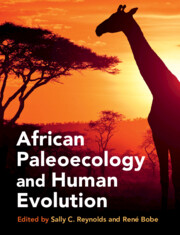Book contents
- African Paleoecology and Human Evolution
- African Paleoecology and Human Evolution
- Copyright page
- Dedication
- Contents
- Contributors
- Acknowledgments
- Part I Modern Africa and Overview of Late Cenozoic Paleoenvironments
- Part II Southern Africa
- Part III Eastern and Central Africa
- Part IV Northern Africa
- 36 The Northern African Sites: Paleoenvironmental Syntheses
- 37 Ahl al Oughlam, Morocco: The Richest Fossil Site in North Africa at the Pliocene/Pleistocene Boundary
- 38 Tighennif (Ternifine), Algeria: Environments of the Earliest Human Fossils of North Africa in the late Early Pleistocene
- 39 Early Homo on the Atlantic Shore: The Thomas I and Oulad Hamida 1 Quarries, Morocco
- Volume References
- Index
- Plate Section (PDF Only)
36 - The Northern African Sites: Paleoenvironmental Syntheses
from Part IV - Northern Africa
Published online by Cambridge University Press: 19 May 2022
- African Paleoecology and Human Evolution
- African Paleoecology and Human Evolution
- Copyright page
- Dedication
- Contents
- Contributors
- Acknowledgments
- Part I Modern Africa and Overview of Late Cenozoic Paleoenvironments
- Part II Southern Africa
- Part III Eastern and Central Africa
- Part IV Northern Africa
- 36 The Northern African Sites: Paleoenvironmental Syntheses
- 37 Ahl al Oughlam, Morocco: The Richest Fossil Site in North Africa at the Pliocene/Pleistocene Boundary
- 38 Tighennif (Ternifine), Algeria: Environments of the Earliest Human Fossils of North Africa in the late Early Pleistocene
- 39 Early Homo on the Atlantic Shore: The Thomas I and Oulad Hamida 1 Quarries, Morocco
- Volume References
- Index
- Plate Section (PDF Only)
Summary
The history of paleontological research in northern Africa goes back to the first half of the nineteenth century, when French zoologists discovered the first fossil mammals in Algerian caves. In 1851, Duvernoy described the long-horned buffalo “Bubalus” antiquus, the first fossil mammal ever named from Africa. Further discoveries and descriptions of fossil mammals were made in Algeria by French paleontologists (Gervais, Gaudry) in the mid-nineteenth century. Philippe Thomas (1884) named several species, including the first fossil monkey reported from Africa, “Cynocephalus” atlanticus, and he established the co-occurrence of Hipparion and Equus at Aïn Jourdel. However, it is only with the first excavations made at Palikao (Tighennif) near Oran that extinct mammals were found definitely associated with a Paleolithic industry (Pomel, 1886). Between 1893 and 1897 Pomel published a series of monographs on Algerian fossil mammals: even though most of the finds that he described are of late Pleistocene age, with the notable exception of those from Tighennif, his work, which includes a number of new species, remains a benchmark in African paleomammalogy, at a time when virtually nothing was known south of the Sahara. Research on early hominin sites in the twentieth century is associated with the name of Camille Arambourg, who spent most of his childhood in Algeria, and excavated a number of fossil sites of various ages there (Hadjouis, 2010). His early research focused on upper Pleistocene caves along the Algerian shoreline, but as early as 1931 he started excavating several sites known since the nineteenth century near El Eulma. He discovered the Pliocene sites of Lake Ichkeul and Aïn Brimba in Tunisia and the lower Pleistocene sites of Aïn Boucherit and Aïn Hanech in Algeria (Arambourg, 1970, 1979). The latter site yielded the earliest known man-made artifacts of North Africa; it has been under renewed research by Sahnouni and colleagues for more than 20 years (Sahnouni et al., 2018, and references therein), making it one of the most important North African sites. Later, Arambourg conducted large-scale excavations at Tighennif, but published only the hominin fossils from this site, erecting for them the binomen Atlanthropus mauritanicus, probably a synonym of Homo heidelbergensis or H. rhodesiensis; they remain the earliest North African fossil hominins. The last important site excavated by Arambourg in Algeria is that of Bou Hanifia (also known as Oued el Hammam), of late Miocene age (Arambourg, 1959).
- Type
- Chapter
- Information
- African Paleoecology and Human Evolution , pp. 461 - 467Publisher: Cambridge University PressPrint publication year: 2022



